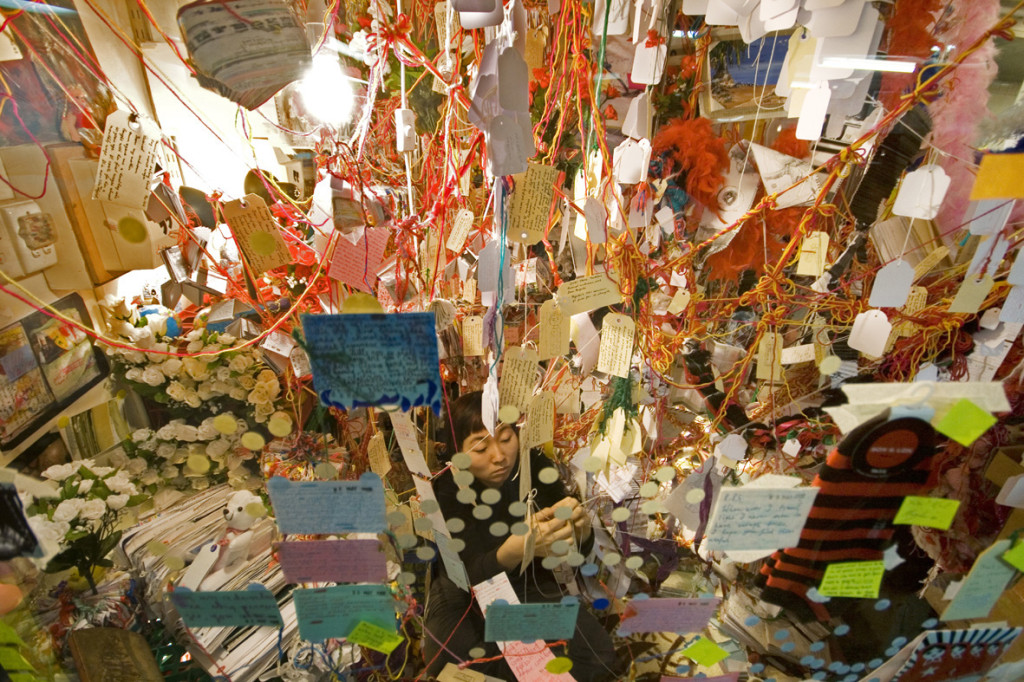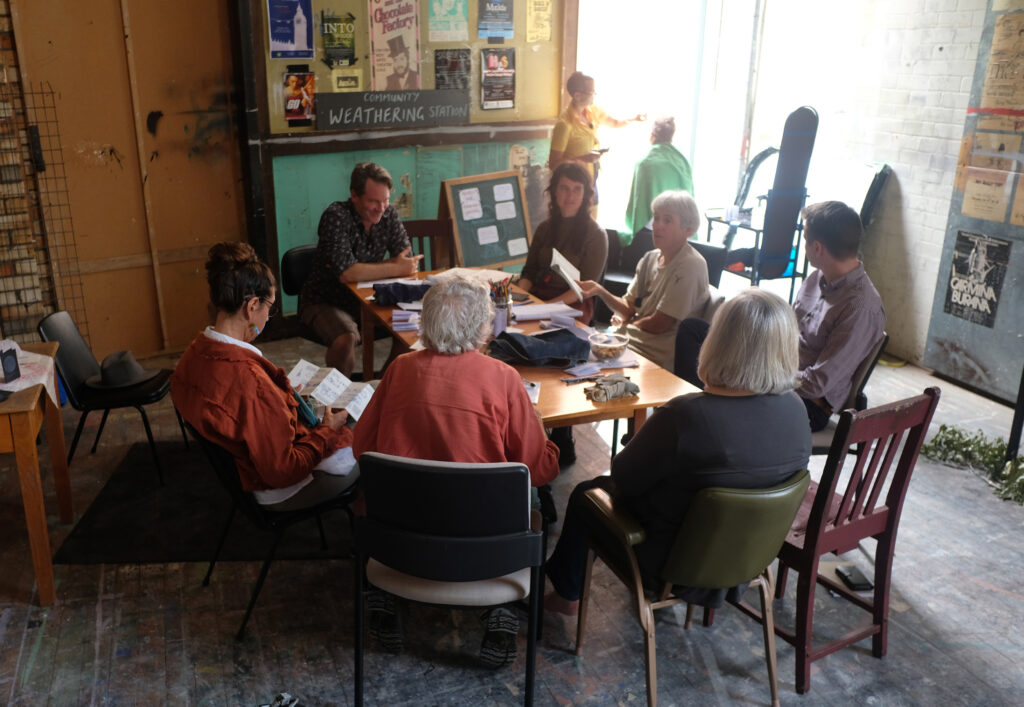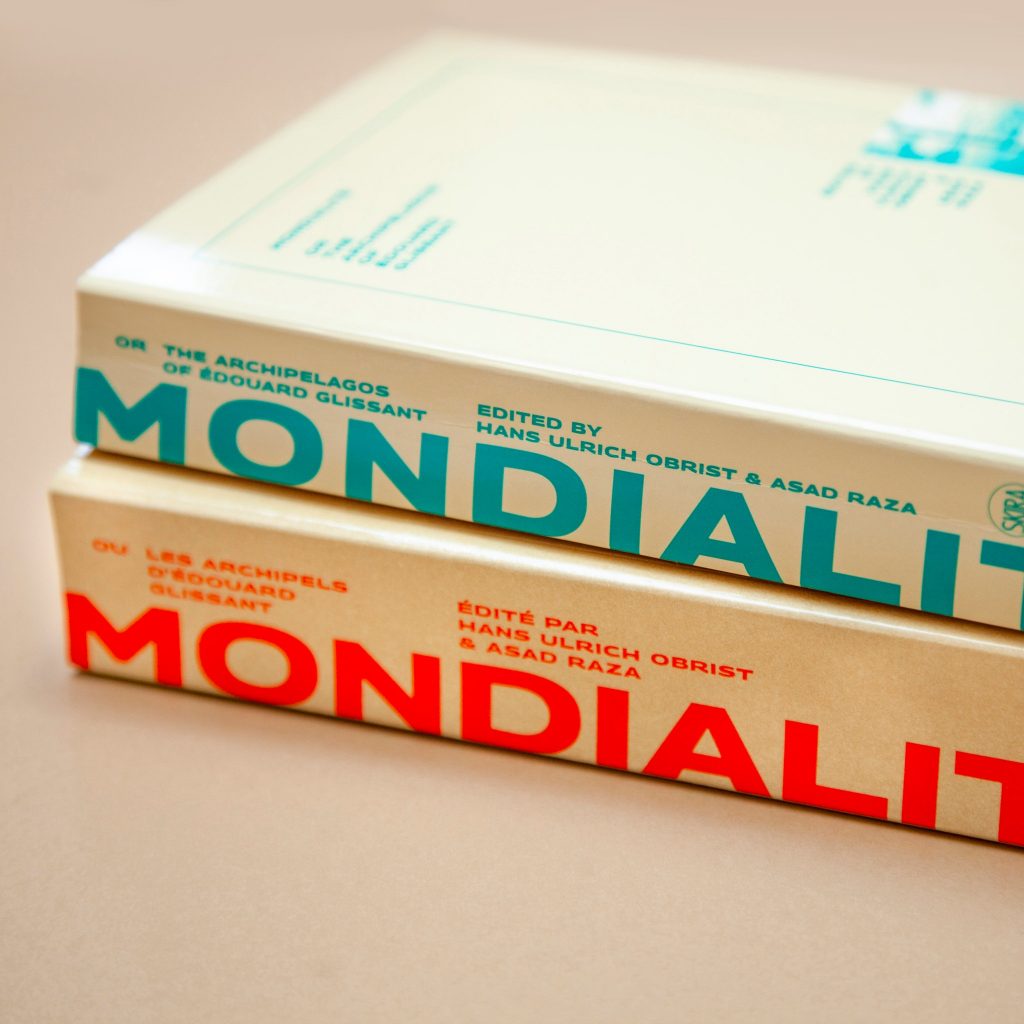
Reflecting on Hiromi Tango’s Absence
by Tessa Zettel

Absence
Hiromi Tango
2 – 31 May 2008
Platform, Melbourne
[First published in November 2008 in un magazine 2.2. An earlier version also appeared in Hiromi Tango‘s single-edition artist book, Absence (2008).]
Dear Hiromi,
At the opening of Absence, midway through Hiromi Tango’s month-long residency in the grimy underground transit space of Platform, clumps of people holding plastic cups of wine gather around a tiny shop window plastered with psychedelic sticky notes in fruit tingle colours, edges peeling away with scrawled messages that include ‘I really hope this never ends’ and ‘I still love you’. Through what’s left of the glass the occupied interior is just visible – an improbable tangle of spidery webs of wool and thread, balloon strings and little blank gift tags. Peering into this miniature world, Hiromi herself can be seen pinning up pieces of paper with outlined letters that offer cups of tea from a newly acquired electric kettle and elusive statements like ‘I am so sad and I miss you terribly’. When a packet of jelly babies pokes out of a letterbox in the door, someone politely bends down and takes one, returning a minute later to slip through a drawing in return, which subsequently turns up in a clear patch of window, sticky-taped from inside.
There are many kilometres of suburbs and dry farmland and rainforest and bitumen stretching between us now, and I wonder where you are exactly and if you are sewing a floating page of someone’s diary into the folds of someone else’s handwritten note to no-one in particular.
A week later, two teenagers are writing letters at a nearby ledge piled with pens and notepads. Hiromi drops in to collect something and a guy in a puffy black jacket asks her bluntly what ‘this’ is. She beams and tells him it’s whatever he wants it to be. He seems disarmed and asks if it’s hers, to which she answers ‘it’s ours!’. This brief exchange somehow captures the simplicity and sincerity at the heart of the project, which unfolds as an open platform for interaction, a multi-directional conversation that is shaped and owned by participants. Usually based in Brisbane, Hiromi has spent eighteen months researching for the project in the USA, New Zealand and around Australia, collecting letters and notes and personal objects from people she encounters and stitching these into little books that are micro-architectures of human emotion and our capacity to share pieces of ourselves with complete strangers. These handmade books form part of the installation at Platform, as do plastic milk crates laden with bunches of pink and yellow fabric flowers and moments of unexpected intimacy that bloom between cracked concrete and stuffy air.
Your work makes me think of the Pitjantjatjara concept of reciprocity, Ngapartji Ngapartji, which is also the name of an intercultural arts and language project based in Alice Springs that Karl and I have been working on as designers for the past few years. We work with them remotely and have only been to visit once. I’d like to go back and see everyone again but the plane tickets are so expensive. Ngapartji Ngapartji underlies social relations in Pitjantjatjara culture and means ‘I give you something, you give me something’. In this case I give you a page torn from my diary, you give me a biscuit, I give you a bedraggled piece of my heart or a date-stamped sticky note with the words ‘raisin toast makes me happy’, you give me a wide open-eyed smile or maybe one end of a ball of red wool.
Much discussion has taken place in recent years around relational aesthetics, whereby an artwork is judged in terms of the inter-human relations it prompts or provokes. Regular passers-by become attached to Absence and bring presents; around the subway floats a kind of ad hoc, temporary community, a space between people that is active and real and would otherwise be absent from this somewhat dank corner of the city. There is an inherent tension between absence and presence in the work and the way we encounter it. Stories of loss and distance remind us that physical absence is always there, hovering at the edges of daily interactions and routines that connect us to the circumnavigations of work and life. But we are also being asked to make presence matter, to be present in the moment and not absent from it, to make the present meaningful and connected.
Karl and I ended up at an opening at the Blender one night, which I remembered was the warehouse you were camping in. Behind the gallery I found your tent wedged between studios, and was astonished at how similar this makeshift living space was to the installation at Platform, dripping with plastic flowers and half-buried between notes and books and multi-coloured paraphernalia which, in its obsessive compulsive profusion of detail, somehow looked deliberate and ‘artful’. In front was a cardboard sign that said: ‘In memory of Hiromi Tango, Died 24-5-08, Age 32, four months pregnant, Franklin St. Melbourne’. There were a lot of people around, drinking and whatnot, but no-one I knew, and perhaps they hadn’t yet noticed the sign. I felt very quiet and anxious, and when we eventually came across Tai she thought we’d had a fight. Actually I was worried that you had in fact been killed in some kind of car accident. I had expected you to be there but you were not.
Andrew Benjamin describes the city as ‘a site of movement’ in which interventions undo the rigid distinctions of modern urbanism. 1 The insertion of a space for lingering, for laughter, surprise and memory, into a thoroughfare connecting retail space to networks of transport and labour certainly complicates our experience of urban space. There are threads here leading back to the Situationists who, in 1940s Paris, proposed ‘constructed situations’ as an antidote to the burgeoning spectacle of modernity. These engineered moments combined environment and people to generate new ways of seeing the world and behaviours evoking a future social life of human encounter and play. The Situationists envisaged the reconfigured city as a heterogenous patchwork of different emotional zones -– the Happy Quarter, the Bizarre Quarter, the Sinister Quarter and so on. The most tangible articulation of this was Constant Nieuwenhuys’ New Babylon, a vision of a new city overlaid above the existing one, with moveable superstructures allowing drifting, experimental interaction. It is tempting to see in Absence a tiny, inverted pocket of New Babylon, overflowing with melancholy, heartfelt expression and offered up for ordinary citizens to construct as they wish. At this micro-scale the world is accosted with a post-it note that declares ‘I feel like destroying something beautiful’.
Thanks for sending me your ‘special pregnant woman love wave (5 months limited edition)’. I hope you are in good health and have found time to take something of a pause … Karl and I both miss having you nearby and look forward to spending some time in the same city one day soon, when we can cook delicious soup and go for walks together whenever we like.
On the final day Hiromi lies stiff and unmoving across a row of milk crates outside the curved shopfront, head resting on an embroidered silk pillow, arms folded over a bouquet of flowers. There are towers of little books everywhere, spilling from the wall and the floor and Hiromi herself. What does it mean for art practice when a work occurs just below the rhythms of daily life; with the artist present and able to respond, so that it can continue to bounce back and forth and take on new intentions and formulations as it grows? Perhaps under these circumstances the city can breathe through it. In the Next Wave festival program, Absence is credited as a collaboration between ‘Hiromi Tango and the people of Melbourne’. This is suggestive of the warmth and generosity behind the work, and of the potential empowerment at stake when an artist takes the risk of inviting ‘audiences’ to become active producers of ‘public’ art. As a kind of elegy to departures and dreams, she rests
silently beneath a kaleidoscope of colour and words, in which the city is broken up into a million tiny pieces and refracted back in shifting human patterns that fall away and recombine on every turn.
With love, Tessa
IMAGE CREDITS
TOP & BOTTOM LEFT: Hiromi Tango Absence (2008) – Photos by Jorge de Araujo
BOTTOM RIGHT: Hiromi Tango Absence (2008) – Photo by the author
———————————————————————————————————-
Postcript (November 2008)
After reading Claire Bishop – ‘The Social Turn: Collaboration and its discontents’*
I read this article not long after I’d finished writing the above piece about Hiromi Tango’s Absence, and took the opportunity to reconsider the work in light of some new ideas. It dates from a few years ago and attempts to sketch out some kind of interpretive framework for contemporary relational art practices. She’s critical of how much discussion of collectively-produced or participatory art projects concentrates only on the ethics of the work’s production and the decentralisation of its ‘author’. This is probably true of my piece about Absence, which was, however, always meant to be personal, and that was very much my own overriding personal reaction – a kind of wonderment at Hiromi as a character and at the expansive ‘heteronomy’, the blurring of art and life that she seems to embody.
It does seem that I was perhaps overly struck by the simple fact that Hiromi allows participants to be co-creators, by her deployment of a ‘superior model of collaborative practice’, preferencing true and authentic respect for the other. Perhaps if I were writing it now I would refer to Bishop’s reservations about this evaluative response. I might look a little closer at the nature of the work’s content, ie. the messiness of human separation/absence; the alienation of the modern, globalised city in which we are rendered passive consumers and often simply don’t have the time or space to connect with each other in meaningful ways or reflect on personal loss or melancholy (perhaps a reference to the cemetery here would be interesting, public mourning, a shared space to confront grief); the attempt to piece together some kind of temporary community, founded upside down on those who are missing.
I would probably place this type of work in opposition to that of groups like Oda Projesi, in that Hiromi’s own distinctive aesthetic sensibility dominates and even structures how Absence operates (the attention to detail; the fracturing into small, perfectly polished pieces; the valorising of the mundane – I remember she once said to me ‘I always enjoy what I eat, whether it’s a lolly or a beautiful meal’; the transformation of this ‘nothingness’ – ordinary string, gift tags etc. – into something more than itself, something monumental and phantasmagoric). Perhaps I could have teased out some of the contradictions at work here: the happiness of the lolly-pop psychedelia against the melancholy content of the expressions, the festive Mexican mortality of it all; the articulation of loss and distance against the apparent coming-together and participatory operations of the work; the intense presence of the artist as a central figure against her inevitable departure; the serious appreciation and engagement of most participants with the proposed theme of the work against the sly (but welcomed) resistance of some: the evangelists, the silly, the crude (in some ways the embrace of this rupturing reminds us to not take the Artist at face value, to not assume that their preoccupations resonate at all times with all members of the public).
Why is it surprising and pleasurable for us to hear intimate stories from strangers? Is it simply a voyeuristic impulse, a grim fascination with the suffering of others, consumed from the safety of our own anonymity? Maybe it is also disarming because it reveals how little we do know about our neighbours or the people we share our streets and shops and office buildings with, how rarely we speak to each other, openly and sincerely, about what depresses, haunts and saddens us. In this sense the work traverses what Bishop refers to as ‘a more complex knot of concerns about pleasure, visibility, engagement and the conventions of social interaction’. It lets slip how little room we make in our lives for these internalised absences, allowing us briefly to indeed ‘confront darker, more painfully complicated considerations of our predicament’. And perhaps this art – autonomous, unexpected and temporal – can produce such contemplative ruptures, like tiny air-bubbles in dough, precisely because of its ultimate location outside those passages of daily life.
*Published in Artforum, Feb 2006.
- Andrew Benjamin, ‘Fraying Lines’, in Richard Goodwin, Richard Goodwin: Performance to Porosity, Craftsman House, Fishermans Bend, Vic, 2006, p. 157 ↩




